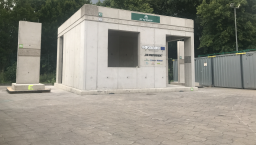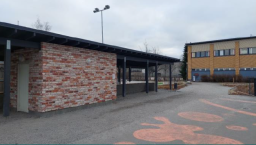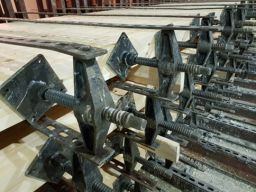

Transforming a 1930s commercial site into student housing
Virtual Demonstrator
Overview
Buildings on the commercial plot were originally developed for manufacturing, including production of timber, soda water and cast metal products.
Currently, the site houses businesses including auto repair shops, a night club, musicians’ studios, start-up companies and education services.
Threat of demolition
Industrial buildings account for the vast majority of demolished area in Denmark. Typically, a site like this is sold to a developer that will demolish it as far as possible so new housing can be built. The huge demand for housing in Denmark and soaring residential prices means the developer is likely to build at high density.
Transformation project
CIRCuIT partners in Copenhagen and local built environment stakeholders investigated how the site could be transformed into affordable student housing. Overall, the circular intervention’s lower material consumption resulted in a potential CO2 saving of 23%.
Key findings
Public data has an important role in assessing transformation potential. A publicly available database made it possible to create static calculations and a 3D model of the building’s construction and layout to support the design process.


Gröninger HÖf Parkhaus – Giving new life to a heritage‑listed building
Physical Demonstrator
Overview
This building is in a popular resort on the Baltic coast of Schleswig-Holstein, about 85km north-east of Hamburg city centre.
It was built as a one-storey car dealership in the mid-1950s and extended several times in the following years. In the early 2000s parts of the structure (sales areas) were heritage-listed because of the curved glass façade. In the last years before conversion, the building was briefly vacant during planning and project development. .
Threat of demolition
Gaining heritage-listed status meant the building could never be demolished. However, analysis of demolished buildings in Hamburg showed it exhibits many characteristics typical of demolished buildings. This includes the commercial-industrial function, distant location and small, low-rise character. These buildings are often demolished without second thought to give way for denser and higher development – especially buildings without a heritage listing. A significant problem with buildings like this is how to use them and the land they stand on effectively while retaining spaces and components with preservation potential.
Transformation project
Transformation and extension of the existing heritage-listed building into a gym and vacation apartments was completed in 2020.
By strengthening the structure’s load-bearing capacity three extra levels for vacation apartments were made possible. This resulted in savings of 321 tonnes of materials, 186 tonnes of waste and 74 tonnes of CO2 emissions. The cost of the circular intervention was 4.2% less than demolishing and building new.
Key findings
Early collaboration with heritage protection authorities was key for success. It helped precisely identify areas for preservation, alongside those that could be modified and by how much.
Increased density and a new future-oriented use was achieved through revised room layouts and structural strengthening to enable three new floors above the original building. Close collaboration with architects helped harmoniously integrate modern, high-quality features people would expect with the original heritage look.


Transforming 1970’s public rental housing to accommodate more people
Virtual Demonstrator
Overview
This transformation covers two blocks of flats (one with three floors and one with five floors) in the Hakunila district of Vantaa. Both buildings were completed in similar Modernist style with precast concrete panels in 1979. The buildings have always been social rental housing.
Threat of demolition
There is no particular threat of demolition for the flats. However, there is pressure to demolish existing housing in the area as the urban population rises.
Social rental housing is particularly prone to demolition due to factors like:
typically having only one institutional owner, which eases decision-making on demolition
physical degradation of buildings or lacking necessary flat properties, e.g. in accessibility or demand on flat size
socio-economic environment with precarious groups, neighbourhood image issues
vacancy issues, mismatch of flat size with demand
city’s policy targets for urban densification and social mix/gentrification and the potential value of the plot with a renewed urban plan featuring substantially increased building rights (in m2)
Transformation project
Instead of demolition and replacement, urban densification targets were pursued through a retention and extension approach, with additional floors added on top of the existing buildings. Through consultation with the owner, it was decided there was no need to change the flat or room layouts. They serve the needs of renters well, as evidenced by the low vacancy rate. Instead, it was decided to balance out the flat-size offerings in the buildings with the help of additional floors to house smaller flats. The facades, building services and interiors of existing floors (including flats and shared facilities) were renovated as part of the overall transformation.
Additional floors were designed to be added on top of the existing buildings with the help of steel beams, running from cross-wall to cross-wall. This provides freedom for the placement and sizes of the new flats, as the new walls will not need to coincide with the underlying load-bearing walls.
The wooden load-bearing frame of the additional floors is lighter than concrete and helps to avoid the need to reinforce foundations, but also results in shorter spans. This fact, together with creating smaller flats, means that layouts may not be particularly adaptable in future.
Key findings
If a city has a densification target, extending housing blocks with additional floors can be a technically, economically and environmentally viable alternative to demolition and new build.
The approach is particularly viable in social housing, as there is only one owner who can easily make the decision to transform. Because the building is non-profit, the project’s demonstrated cost saving is more relevant than the potential profit from demolition (a factor that can limit the interest of for-profit housing providers). As public actors, social housing companies could set an example for other types of housing providers.
Depending on the size and shape of the site and its location, a densification target may only be achievable if new buildings are constructed on the site as well as adding additional floors to existing buildings. The terrain and soil of the site may influence whether this is possible and what the cost implications will be.


Extending the life of a 1980s commercial shopping outlet
Virtual Demonstrator
Overview
The subject of the transformation is a large commercial shopping outlet, which was completed in 1987 and functioned as a Do-It-Yourself store.
The structural scheme was created to be column-free through a structural steel spine truss along the length of the building. This is supported at an intermediate point by steel tension cables. The building is clad with sheet metal and sits on a concrete podium deck.
Threat of demolition
A developer recently acquired the outlet and surrounding land. The plan for the site is to build high-rise residential properties and retail outlets on it. This is because of the huge demand for residential properties in London. As a result, the large shopping outlet is at high risk of demolition.
Transformation project
In an attempt to save it, CIRCuIT partners in London explored options for retaining and transforming the whole building. The sectors these options covered included retail, multifunctional/cultural, healthcare, transport, industrial/manufacturing, agricultural, sport and research/educational.
After considering the different options and the potential environmental and economic benefits, the developer decided none of the transformation options were suitable.
However, dismantling and re-erecting the entire structural frame on another site was chosen as an alternative option.
This circular intervention (retaining the substructure, steel frame and roof) would save up to 1.2 million kg of CO2 compared to a new building alternative.
Key findings
This kind of project could potentially be replicated across other out-of-town retail units. This could result in a reduction in whole life carbon emissions of 400,000 tonnes of CO2 across Greater London.


Gladsaxe school / The Swan - Selective disassembly
Physical Demonstrator
Overview
The Gladsaxe school is an interesting case for PDA assessment because it represented two types of buildings – it was built in 1937 and extended in 1967.
Materials from the school were used to construct a new kindergarten on the same site, making it easier to plan for urban mining (see page 2-10). This included wood recovered from demolition in the kindergarten’s entry hall, wooden trusses, steel sheets, pantiles, masonry and specific fixtures and accessories such as lamps and sinks.
Reuse of the wooden trusses was the main focus of the project, with six forming the load-bearing roofing elements in the new kindergarten’s entrance hall.
Nearly 6,000 tonnes of concrete were also crushed and used for the kindergarten’s foundations and site backfilling.
Key actions taken
The pre-demolition audit involved an interdisciplinary team, with stakeholders from the entire construction value chain. Timber rafters from the roof were carefully cut free according to predefined and agreed cutting lines. Three types of steel cladding were dismantled from the building and bricks were taken down using a Cat digger and cleaned manually from mortar. Roofing tiles were also selectively dismantled from the school.
Key findings
The pre-demolition audit of a building should be a process that involves stakeholders from the entire construction value chain to ensure the highest possible level of recycling and reuse. In particular, the demolisher of the existing building and the architect/developer of the new building should go through the existing building together to discuss and agree on reusable/recyclable items.
It’s crucial to use expert reuse consultants for the initial building mapping who can steer cross-disciplinary processes so circular practices are used rather than linear approaches. An open house at the demolition site, a virtual open house or a digital model, could be used early on to connect built environment stakeholders with each other. They can then explore how they would work together to reuse or recycle materials from the existing building.
Storage of extracted materials should be a consideration. For example, the timber extracted from the Gladsaxe school needed to be stored in a place where it was covered and ventilated, so it didn’t rot.
If a developer includes the reuse of building materials in their tender, it will be calculated in project finances from the beginning. That means it’s less likely to be overruled later in a project due to economic or practical reasons.
If building materials are initially regarded as reusable products rather than waste, regulations may state they don’t have to be checked for hazardous substances. As a result, it’s important that an initial screening for hazardous substances takes place along with the PDA to ensure materials that could harm the environment or people don’t remain in the built environment.
Reusing timber is an opportunity to extend the carbon storage of wood. Growing trees store carbon, which is then released when wood is burned. However, assessing wood for reuse is relatively simple, if standards are followed. Reusable wood may be deformed or crooked, which should be considered when designing a new building.


Die Musterbude – Testing the performance of recycled concrete mixtures
Physical Demonstrator
Overview
Die Musterbude is an innovative project that involves the construction of a small cabin using seven types of recycled concrete. Recycled concrete has been used for decades – but this project tested new mixes featuring materials like recycled sand and waste materials from demolished buildings against conventional concrete. The project aimed to assess the technical and environmental qualities of the recycled concrete mixtures against a standard concrete mixture that uses new aggregates.
The recycled concrete, which is derived from crushing and reusing excess concrete from demolished structures, is the primary construction material for the Musterbude.
The project allows a deeper understanding of how recycled concrete performs in real-world applications and its potential benefits in terms of sustainability and material circularity.
By demonstrating the successful use of recycled concrete aggregates, the project sets a compelling case for sustainable construction practices that advance the circular economy in construction.
Key actions taken
The project produced various aggregates from construction and demolition waste. They were tested for optimal screening and washing both in the lab and in the finished construction. Out of this process, seven new recycled concrete recipes were developed. Life cycle assessment and costing was carried out.
Key findings
The project team found mixtures with a higher percentage of recycled concrete have a lower environmental impact. However, mixtures with a higher percentage of recycled concrete lead to more water consumption because of the porosity of recycled aggregate. The amount of water could be reduced by using polycarboxylate superplasticizers (PCEs) in the concrete mix (a chemical admixture) and pre-washing aggregates.
The Hamburger Mische mixture, which contains 100% mixed construction and demolition waste, achieved good concrete strength and surpassed expectations.
Because of these positive results, the mix will be further improved and used locally in Hamburg


Tikkurila school warehouse – Reusing red clay bricks
Physical Demonstrator
Overview
Reclaimed red clay bricks, including from the National Theatre of Finland, were reused to construct a small storage building in the yard of the Tikkurila Pavilion School. Bricks were identified as a prevalent and reusable building material in the pre-demolition audits of two demolition cases in Vantaa.
The aim of the demonstrator project was to develop cost-effective methods to investigate the quality of deconstructed bricks (and potentially other materials). It was also to assess the environmental and economic performance of reused bricks against virgin bricks.
Key actions taken
Bricks were deconstructed with hand-held power tools and an excavator. An assessment was carried out between material properties acquired with indirect (non-destructive) methods and those acquired with direct (destructive) methods. There was also an assessment of the environmental and economic performance of reused bricks in comparison to virgin bricks. Recommendations were noted about appropriate methods and sample sizes. Ultimately, reclaimed bricks were used to build the storage building.
Key findings
Indirect methods to study the material properties of reclaimed bricks include assessing the colour of a brick and its pitch when struck to sort into different categories. Compression strength and freeze-thaw durability of a reclaimed brick can be evaluated with ultrasonic pulse velocity. Both are rapid, low-expense tests that can be performed at a demolition site. This contributes to the cost-effectiveness of the reuse process. However, only laboratory tests can determine compression strength and freeze-thaw resistance accurately.
Reused bricks must be selected carefully for the right area of a building to ensure an ‘attractive’ side of the brick is visible. This selection takes more time than using new bricks.


Glulam from secondary timber
Physical Demonstrator
Overview
The London demonstrator investigated the technical and logistical feasibility of upcycling reclaimed timber into new building components.
This involved retrieving timber from demolition sites, characterising and quality-testing the material, preparing it for manufacture and fabricating new glued-laminated timber building components.
Key actions taken
Timber was reclaimed from building demolition sites. The reclaimed timber was characterised, visually and mechanically, to prepare it for the manufacturer. New laminated timber building components were manufactured from reclaimed timber.
Bending tests and shear tests were carried out on the glulam beams. Test results were compared with benchmark results of glulam fabricated from virgin timber. Finally, recommendations were provided on deconstruction, regrading and manufacture in relation to secondary timber laminated building components.
Key findings
There was good correlation between non-destructive and destructive testing of the stiffness of manufactured secondary timber glulam beams. As stiffness is a good indicator of strength, this suggests that secondary timber glulam beams could be commercially tested using non-destructive methods (as is the case with virgin glulam products) to verify product performance.
The glulam beams made of secondary timbers performed to structural glulam standards.
No additional time is needed for removal of timber compared to business-as-usual demolition practices. If it takes no longer to remove the timber then there isn’t a cost premium on accessing the material.
Identification and removal of screws, nails and staples is crucial to avoid damaging the tools used in the glulam manufacturing process.
Longer secondary timber lengths, ideally 1.5m or longer, enable a cost-effective manufacturing process by minimising the number of finger joints required.

Adaptable housing
Physical Demonstrator
City context
In Copenhagen, new residential buildings tend to be designed to the same specifications. In fact, 66% of apartments have three rooms and the floor area of the flat is between 85–115m2, not including outside areas such as storage space, a balcony, etc.
Currently, prefabricated concrete construction with loadbearing walls are the norm in Danish construction. In this approach, structural concrete elements are cast together to form internal and external walls and floor slabs. However, this limits flexibility, both horizontally and vertically, and the structural elements are difficult to modify without major interventions. Services like underfloor heating, drainage and electricity are often integrated into the concrete. This makes them difficult to access for maintenance or replacement without demolishing part of the structure.
Projections show an increasing need for smaller one and two-room apartments in Copenhagen. But because of the way Danish buildings are currently constructed, it’s unlikely a simple layout shift alone could meet future demands. This means buildings are at risk of being prematurely demolished in favour of new dwellings.
DfD and DfA approach
The adaptable housing demonstration project in Copenhagen aimed to show how apartment blocks that use DfD and DfA principles could meet future housing demand and deliver significant environmental and economic benefits.
The demonstrator showcased an alternative structural system based on frame construction. It included a frame system without loadbearing walls. Slabs could be removed to significantly increase adaptability, both horizontally and vertically.
In addition, including mechanical fixings and lime mortar instead of cement allowed components to be dismantled. Design enabling disassembly of building layers, avoiding cast-in services and replacing concrete screed with sand enabled services to be replaced or maintained easily without major interventions.
The demonstrator also included standard prefabricated elements such as concrete columns, concrete core, steel beams and hollow core slabs.
Key findings
Compared to a business as usual (BAU) case study, the DfD and DfA approach had a substantially higher reuse potential (85%).
Results also indicated that the embodied carbon of the BAU approach and the DfD and DfA approach were almost the same after a single building lifecycle. However, if the DfD and DfA buildings were redeveloped, there would be an embodied carbon saving of 37% after the first redevelopment and 50% after the second.
Constructing the alternative buildings and disassembling them would be 25–28% more expensive than using the BAU approach and demolition. However, if the alternative buildings were redeveloped, there would be a 27% cost saving after the first development, and 45% after the second.
Adopting DfD and DfA principles may require a higher upfront investment, but by extending the lifecycle of a building and its elements, there can be substantial environmental and economic benefits after just one redevelopment.


The Klassenhäuser structure – slab construction
Physical Demonstrator
City context
In Hamburg, several schools were built using comparable design concepts. This demonstrator aimed to compare the impact of conventional construction floor slabs against three DfD versions.
DfD and DfA approach
The BAU case for this design was a conventional floor slab made using an in-situ concrete method. Three different types of DfD floor slabs were made using pre-stressed concrete cast elements, pre-stressed concrete cast elements with seam and joint and a bolted timber-concrete construction method to aid disassembly and reuse.
Key Findings
The demonstrator found that the DfD slabs could be dismantled completely and sorted by material type. The DfD floor slabs used 40% less concrete, representing significant material savings and associated carbon impacts. Additionally, the DfD slabs interlocked, which meant, unlike traditional methods, no gaps needed to be sealed.
Using the pre-stressed concrete slab with seam and joint did result in dimensional differences. The DfD school building was 50cm higher than the comparable BAU building, which affected wall heights, staircase and railing lengths, pipe lengths and the distance between the building’s columns. These had to be reduced, resulting in more columns and fewer open spaces, which is a drawback that would need to be considered when weighing up the benefits of using this method.
Overall, the demonstrator showed that using DfD slabs could lead to a 70% cost saving over multiple lifecycles of the building, as well as significant carbon savings.


Design for disassembly warehouse
Virtual Demonstrator
City context
Traditionally, warehouses are designed to remain in a fixed location, be in use for around 20–40 years, then demolished, typically a long time before their technical lifespan is complete. Demolition is more likely to occur because of economic redundancy than technical limitations.
DfD and DfA approach
A single-storey steel framed DfD warehouse was designed that could be dismantled and reused in another location. The warehouse used demountable concrete foundations to allow for disassembly. All connections in the steel and concrete structure were bolted. The columns were also given the option of variable heights, allowing the warehouse hall to be either 5 metres or 3 metres tall. This DfD warehouse was then compared to a conventionally built warehouse in terms of environmental and economic impact.
Key findings
Almost 100% of the DfD warehouse materials could be reused or recycled at the end of life.
Lifecycle assessment (LCA) calculations showed that over three lifecycles (relocating the DfD warehouse compared to building a new conventional warehouse) there were carbon savings of around 40%. Over two lifecycles, calculations showed that the DfD warehouse had significant cost savings, and over three lifecycles the cost saving was 41%.
Overall, it was found that applying DfD methodologies to a warehouse can be challenging because of compliance with regulations for factors such as loads, fire class and building purpose. This challenge should be taken into account in the early stages of DfD design.


Albion Street (The Hithe) – Flexible temporary building
Physical Demonstrator
City context
In London, some local authorities have small parcels of centrally located but underused land that currently only host low-value uses such as storage. To trial new uses for the space, ‘meanwhile use’ construction can be valuable to provide amenities for residents.
DfD and DfA approach
A two-storey affordable office building was designed and constructed using DfD and DfA principles. The building was intended to be disassembled and relocated after 10 years, due to the lease terms for the land it was built on.
The DfD and DfA design was compared against a BAU case study in terms of its environmental and economic impact. A key difference between the two designs was that the DfD and DfA design used modular demountable structural insulated panels (SIP). The BAU design used a traditional steel frame with low-tech timber rainscreen cladding.
Key findings
The economic impact assessment found that the DfD and DfA approach resulted in a 6% increase in construction cost compared to the BAU approach. However, there was a 23% reduction in overall whole life costs.
The results of the LCA study showed an initial 6% increase in whole-life embodied carbon over the BAU base case after the initial construction and use cycle. After the first redevelopment cycle, there was a 30% overall saving in whole-life embodied carbon against the BAU case study. After the second redevelopment cycle, this increased to an overall saving of 46%.
The demonstrator showed that its lifetime could be prolonged by at least 30 years. This was a 200% increase over the BAU case study. It is based on a functional need (use cycle) of 10 years and an ability to accommodate at least two additional use cycles.
The demonstrator targeted a 100% demountable design. However, general wear and tear will likely lead to replacement of materials in a redevelopment. Therefore, a waste allowance of 5% loss during disassembly and 5% loss due to wear and tear was assumed. This means 90% of the building elements for the DfD and DfA approach are estimated to be demountable/reusable.